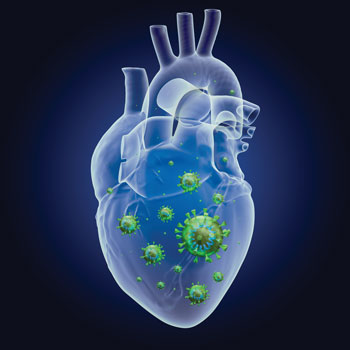More clarity on myocarditis with mRNA COVID-19 vaccines
The classic presentation for COVID-19 vaccine-associated myocarditis is chest pain one to seven days after vaccination, with a median time of three days after vaccination, particularly after the second dose.
Myocarditis has been associated with both SARS-CoV-2 infection and, much less frequently, the mRNA vaccines developed to fight the virus. At the Heart Failure Society of America's annual meeting in October 2022, Margaret Ryan, MD, MPH, reviewed the data on myocarditis risk and vaccine benefits.
While the overall incidence of viral myocarditis is estimated at about 10 to 100 cases per million people per year, SARS-CoV-2 is associated with estimated rates as high as 1,000 cases per million, said Dr. Ryan, who works for the U.S. Department of Defense in the immunization health care division and is a clinical professor in the Herbert Wertheim School of Public Health and Human Longevity Science at the University of California, San Diego.

“Now, when we are considering different incidence rates, we may be talking about screening that's done on either subclinical or even asymptomatic people [with SARS-CoV-2 infection] and looking for very sensitive markers of myocarditis. But myocarditis is at least recognized in as many as 40 per million patients, and of course we see it more in hospitalized patients,” she said. “So if the denominator is hospitalized patients, very sick patients, then the myocarditis incidence is estimated to be much higher.”
Myocarditis has also been seen with the mRNA COVID-19 vaccines. In April 2021, shortly after the vaccines were rolled out worldwide, the U.S. military noted a cluster of myocarditis cases in previously healthy young men, Dr. Ryan recounted. “I do remember my colleague … talking to me about this, and I thought, ‘No, that's just coincidental. We're not going to see that as an actual association,’ but he was absolutely right. The causal association was really fully established within the following months.”
According to case definitions established by the CDC and the international Brighton Collaboration, the classic presentation for COVID-19 vaccine-associated myocarditis is chest pain one to seven days after vaccination, with a median time of three days after vaccination, particularly after the second dose. The risk of myocarditis is much higher in young men, Dr. Ryan said.
CDC data published in the Jan. 25, 2022, JAMA show myocarditis rates of about 1 per million in the seven-day window after COVID-19 vaccination in women and in older people, but “the rates in young men are as high as 100 per million,” she said. “These rates are really 80- to 100-fold higher than expected, so it's a very strong safety signal. The signal is obscured if we look at the whole population and not focus exactly on that risk group, which is adolescent/young adult men, particularly after the second [vaccine] dose.”
Researchers believe that this is an immune-mediated phenomenon, Dr. Ryan said, but pathologic specimens have been limited, given the generally good outcomes. “We don't tend to do very many cardiac biopsies on patients with this phenomenon. Again, we're talking about mostly young healthy men who are experiencing it,” she said. The clinical course is variable but relatively benign. While most patients are briefly hospitalized, approximately one-third recover fully within a week and approximately two-thirds recover fully by six months, she explained. Fatalities are very rare but may occur in patients with underlying conditions, she said.
Some patients report symptoms over the longer term, including episodic chest pain, reduced exercise tolerance, or both, according to Dr. Ryan. “They may be able to comfortably work at some level, including at some level as a student or even in the military, but not able to do extreme exercise,” she said. “So in the military, some patients may be discharged … because of the requirement for being an athlete.”
The American College of Cardiology's 2022 Decision Pathway on Cardiovascular Sequelae of COVID-19 recommends that patients with COVID-19 vaccine-associated myocarditis limit strenuous activity for three to six months and that this condition be diagnosed, categorized, and treated the same as myocarditis after SARS-CoV-2 infection, Dr. Ryan said.
Dr. Ryan noted that myocarditis is also associated with the live replicating smallpox vaccine (ACAM2000). Smallpox vaccine is rarely administered outside the military, since natural smallpox infection was globally eradicated in 1980. When myocarditis occurs after smallpox vaccine, symptoms present a median of nine days after vaccination but otherwise follow a clinical course similar to that of COVID-19 vaccine-associated myocarditis, she said.
Based on its experience with myocarditis after ACAM2000, the military has developed a clinical algorithm to help ensure appropriate evaluation of all postvaccine cardiac symptoms and maintains a registry of all verified vaccine-related cardiac injuries for long-term follow-up. That has provided some helpful information on long-term prognosis of patients with COVID-19 vaccine-associated myocarditis, Dr. Ryan explained.
“It does seem that about one-third of the people who experienced this phenomenon will not have full spontaneous resolution, although they may do well in terms of activities of daily living,” she said. Areas of future research may include randomized trials of treatment for persistent symptoms, she noted.
Regarding whether patients who have had COVID-19 vaccine-related myocarditis can safely receive future vaccinations against COVID-19, “That's really an interesting question,” Dr. Ryan said. “CDC has said that shared clinical decision making is appropriate, and again, we really don't want people to get sick with COVID, so there is a good question about whether or not we should continue to vaccinate people who have experienced this.”
The U.S. military is following a few patients who developed myocarditis after the smallpox vaccine, recovered, and developed it again after a COVID-19 vaccine. “I can share that these few patients have done well and recovered after their second episode. But still, that is an interesting and perhaps unexpected finding of recurrence after two different vaccines,” Dr. Ryan said.
It also raises the question of whether booster doses of COVID-19 vaccines could also cause recurrences, she said, since additional boosters may be recommended in the future. “So far, the risk of myocarditis after boosters appears to be lower than after the second dose—but the risk is still higher than expected, particularly in young males,” Dr. Ryan said. For comparison, rates of myocarditis after the second dose may be as high as 100 cases per million, and rates after booster doses may be as high as 30 cases per million.
Data from other countries where mRNA vaccines were initially given at varying intervals indicate that it may be possible to reduce myocarditis risk (and improve immune response) by spacing out vaccine doses, Dr. Ryan said. “The only risk of spacing the vaccine interval is, in the midst of the pandemic, particularly in the delta wave, we didn't want to space intervals when we were worried about [bad outcomes of COVID-19]. But at this point, we can more confidently recommend spacing the intervals in the primary series,” she said. “In young people, particularly young males who have not yet been vaccinated, that's an important statement. Spacing the interval may be exactly the right thing to do for a young man who has not yet been vaccinated and has a lower risk of COVID.” The CDC recommends considering expanding the usual three- to four-week interval to eight weeks in younger males if threat of COVID-19 infection is not high, she said.
Dr. Ryan also noted that myocarditis has been found more often after the Moderna mRNA COVID-19 vaccine than the Pfizer-BioNTech one. “The Moderna vaccine seems to be associated with about a one and a half times greater risk of myocarditis,” she said. “CDC has not made a preferential recommendation, but does publicly acknowledge that Pfizer vaccine is associated with a slightly lower risk of myocarditis.”
Experts are also keeping an eye on whether the risk-benefit data continue to support additional COVID-19 vaccines for every demographic group, Dr. Ryan said. In the first year of vaccine availability, the risk-benefit data clearly favored vaccination whether “benefit” was defined as reducing all COVID-19 morbidity or only COVID-19 myocarditis. But as these data evolve, and if COVID-19 morbidity continues to decrease, that risk-benefit calculus may change, she said.
In July 2022, the NIH released an updated graphic on the overall population benefit of COVID-19 vaccination, which noted that the risk of developing myocarditis after an mRNA vaccine is lower than the lifetime risk of being struck by lightning. However, Dr. Ryan said she would respectfully disagree about whether that infographic applies to all age groups. Recent studies, including one published in Circulation in August 2022, have verified the higher risk for myocarditis after a second dose of mRNA vaccine in younger men.
“NIH currently says ‘Yes, risk-benefit favors vaccination,’ as a relatively simple communication strategy,” she said. “But NIH and all public health leaders know that we need to continually reevaluate risk-benefit of our immunization recommendations.”



